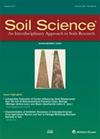Effects of innovative long-term soil and crop management on topsoil properties of a Mediterranean soil based on detailed water retention curves
4区 农林科学
Q2 Agricultural and Biological Sciences
引用次数: 4
Abstract
Abstract. The effectiveness of conservation agriculture (CA) and other soil management strategies implying a reduction of tillage has been shown to be site-dependent (crop, clime and soil), and thus any new soil and crop management should be rigorously evaluated before its implementation. Moreover, farmers are normally reluctant to abandon conventional practices if this means putting their production at risk. This study evaluates an innovative soil and crop management (including no-tillage, cover crops and organic amendments) as an alternative to conventional management for rainfed cereal cropping in a calcareous soil in a semi-arid Mediterranean climatic zone of Navarra (Spain), based on the analysis of soil water retention curves (SWRCs) and soil structure. The study was carried out in a small agricultural area in the municipality of Garínoain (Navarre, Spain) devoted to rainfed cereal cropping. No other agricultural area in the whole region of Navarre exists where soil and crop management as proposed herein is practiced. Climate is temperate Mediterranean, and the dominant soil is Fluventic Haploxerept. Within the study area there is a subarea devoted to the proposed soil and crop management (OPM treatment), while there is another subarea where the soil and crop management is conventional in the zone (CM treatment). OPM includes no-tillage (18 years continuous) after conventional tillage, crop rotation, use of cover crops and occasional application of organic amendments. CM involves continuous conventional tillage (chisel plow), mineral fertilization, no cover crops and a lower diversity of crops in the rotation. Undisturbed soil samples from the topsoil and disturbed samples from the tilled layer were collected for both systems. The undisturbed samples were used to obtain the detailed SWRCs in the low suction range using a HYPROP©device. From the SWRCs, different approaches found in the literature to evaluate soil physical quality were calculated. The pore-size distribution was also estimated from the SWRCs. Disturbed samples were used in the laboratory to assess soil structure by means of an aggregate-size fractionation and to perform complementary analysis from which other indicators related to soil functioning and agricultural sustainability were obtained. The approaches evaluated did not show clear differences between treatments. However, the differences in soil quality between the two forms of management were better observed in the pore size distributions and by the analysis of the size distribution and stability of soil aggregates. There was an overabundance of macropores under CM, while the amount of mesopores (available water) and micropores were similar in both treatments. Likewise, more stable macroaggregates were observed in OPM than in CM, as well as more organic C storage, greater microbial activity, and biomass. The proposed management system is providing good results regarding soil physical quality and contributing also to the enhancement of biodiversity, as well as to the improvement in water-use efficiency. Finally, our findings suggest that the adoption of the proposed practice would not result in a loss in yields compared to conventional management.基于详细保水曲线的创新长期土壤和作物管理对地中海土壤表土特性的影响
摘要保护性农业(CA)和其他暗示减少耕作的土壤管理策略的有效性已被证明是依赖于地点(作物、气候和土壤)的,因此任何新的土壤和作物管理在实施之前都应该严格评估。此外,农民通常不愿意放弃传统做法,如果这意味着他们的生产面临风险。本研究基于对土壤保水曲线(SWRCs)和土壤结构的分析,评估了一种创新的土壤和作物管理(包括免耕、覆盖作物和有机改良剂)作为传统管理方法在西班牙纳瓦拉半干旱地中海气候区钙质土壤中雨养谷物种植的替代方案。这项研究是在Garínoain市(西班牙纳瓦拉)一个专门从事雨养谷物种植的小农区内进行的。在整个纳瓦拉地区,没有其他农业区实行本文所建议的土壤和作物管理。气候为温和的地中海气候,主要土壤为流质单普罗基土。在研究区域内,有一个分区专门用于拟议的土壤和作物管理(OPM处理),而另一个分区则是该区域传统的土壤和作物管理(CM处理)。包括常规耕作后的免耕(连续18年),再生产,使用覆盖作物和偶尔施用有机改良剂。CM包括连续的常规耕作(凿犁)、矿物施肥、无覆盖作物和轮作中较低的作物多样性。两种系统均采集表土中未受扰动的土壤样品和耕层中受扰动的土壤样品。使用hyprop©装置对未受扰动的样品在低吸力范围内获得详细的swrc。根据swrc,计算了文献中发现的评估土壤物理质量的不同方法。根据SWRCs对孔隙大小分布进行了估计。在实验室中,扰动样本通过团聚体粒度分馏来评估土壤结构,并进行补充分析,从中获得与土壤功能和农业可持续性相关的其他指标。评估的方法没有显示出治疗之间的明显差异。然而,两种管理方式之间的土壤质量差异在孔隙大小分布和土壤团聚体大小分布和稳定性分析中得到了更好的观察。CM处理下大孔数量较多,中孔(有效水分)和微孔数量相近。同样,OPM比CM更稳定的大团聚体,以及更多的有机碳储存,更大的微生物活性和生物量。提出的管理系统在土壤物理质量方面取得了良好的效果,也有助于增强生物多样性,以及提高水利用效率。最后,我们的研究结果表明,与传统管理相比,采用拟议的实践不会导致产量损失。
本文章由计算机程序翻译,如有差异,请以英文原文为准。
求助全文
约1分钟内获得全文
求助全文
来源期刊

Soil Science
农林科学-土壤科学
CiteScore
2.70
自引率
0.00%
发文量
0
审稿时长
4.4 months
期刊介绍:
Cessation.Soil Science satisfies the professional needs of all scientists and laboratory personnel involved in soil and plant research by publishing primary research reports and critical reviews of basic and applied soil science, especially as it relates to soil and plant studies and general environmental soil science.
Each month, Soil Science presents authoritative research articles from an impressive array of discipline: soil chemistry and biochemistry, physics, fertility and nutrition, soil genesis and morphology, soil microbiology and mineralogy. Of immediate relevance to soil scientists-both industrial and academic-this unique publication also has long-range value for agronomists and environmental scientists.
 求助内容:
求助内容: 应助结果提醒方式:
应助结果提醒方式:


